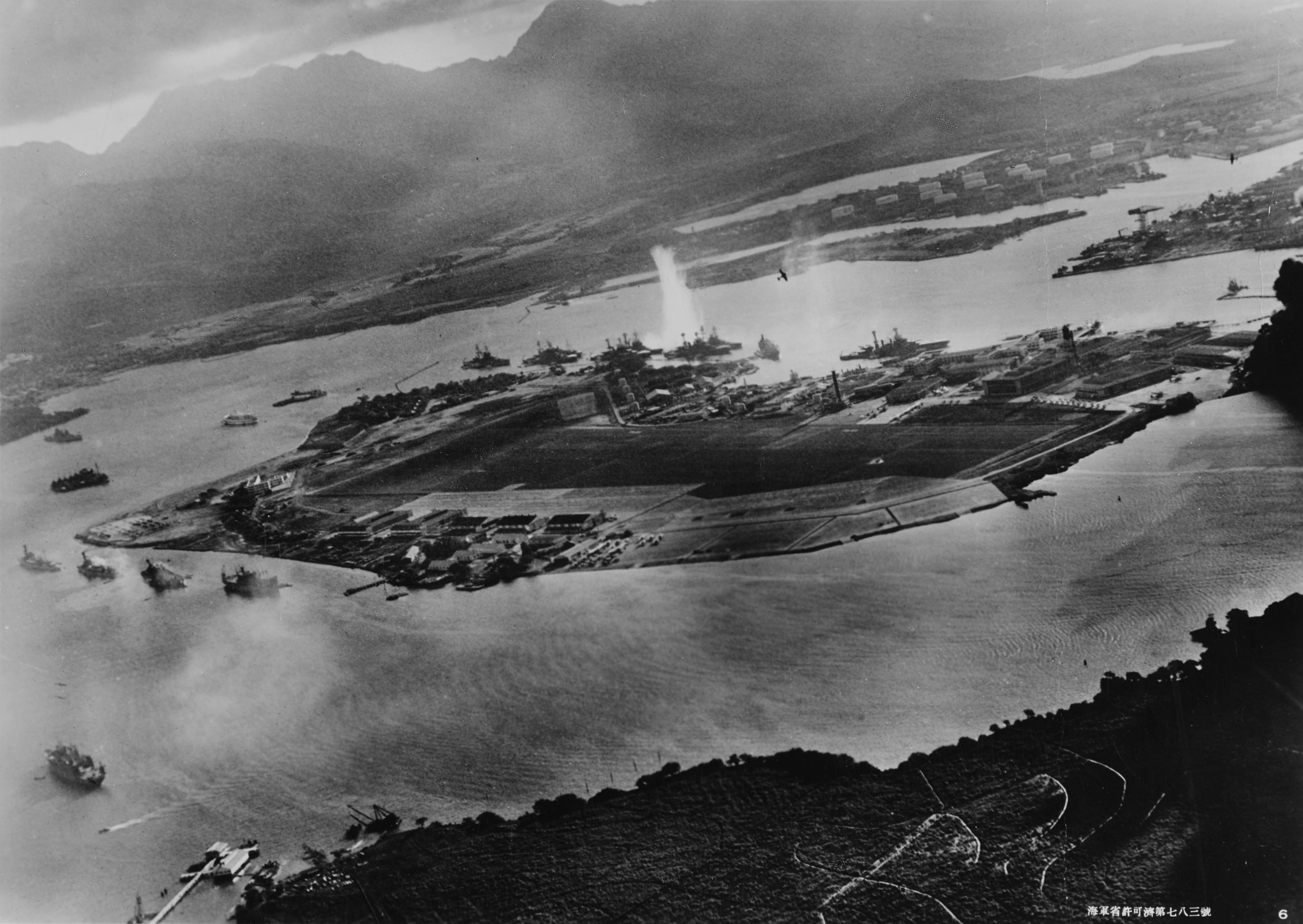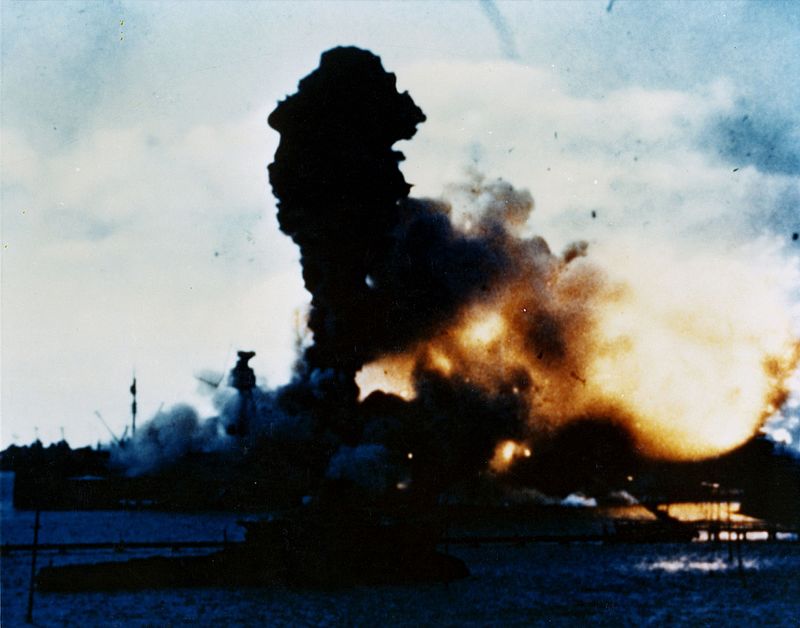As Japanese pilots returned to their carriers on 7 December 1941 following their attack on Pearl Harbor, they left behind a destroyed American fleet. American sailors, soldiers, and Marines enjoying a weekend in paradise were startled out of their bunks by the sounds of enemy planes overhead dropping bombs on a nation that, when they went to sleep the night before, had been at peace. In the space of a few hours on Sunday morning, dozens of ships and hundreds of planes were destroyed, seemingly wiping out our ability to strike back.
But what the Japanese war planners had no idea of when their warships silently slipped out of port on 26 November was the annihilation they would bring upon themselves when the United States used Pearl Harbor as a rallying cry, inspiring millions of young men to join the Armed Forces and avenge the 3,000-plus killed and wounded in the surprise attack. In the words of Admiral Hara Tadaichi, “We won a great tactical victory at Pearl Harbor and thereby lost the war.”
The Japanese had been fighting a war for ten years by the time the Roosevelt administration shut off American oil exports to Japan. This was viewed as an act of war since the Japanese needed vast quantities of oil to run their economy and war machine. So when we cut them off, they turned their sights on invading the oil-rich European colonies in Southeast Asia and the Dutch East Indies.
However, our Pacific Fleet, which had recently transferred its headquarters from San Diego to the territory of Hawaii, stood between Japan and their conquest, and their admirals realized that the only way to get the oil they so desperately needed was to wipe out our ships in a surprise attack.
With submarines standing by at the entrance to Pearl Harbor and Vice Adm. Chuichi Nagumo’s still-undetected 1st Air Fleet closing in on its target, Tokyo sent a message to their diplomats in Washington – which our cryptoanalysts had intercepted – believing the 5,000-word message would arrive in time to announce their declaration of war just before the first wave of aircraft hit Pearl, but the Japanese embassy received the transmission too late to deliver to the U.S. government.
Just before 8:00 a.m. (Hawaii time) 183 planes began hammering our planes on airfields across Hawaii, decimating grounded U.S. aircraft and giving Japanese pilots the air superiority they needed to target our capital ships at will. The battleships were sitting ducks, but our three Pacific aircraft carriers were elsewhere. Not knowing their location was a serious concern for Nagumo and played a role in keeping the task force from launching a potentially ruinous third wave of attacks.

In fact, USS Enterprise (CV-6) was supposed to have been in Pearl that morning, but was delayed by weather. USS Saratoga (CV-4) was picking up aircraft in San Diego after a refit, and USS Lexington (CV-2) was delivering aircraft to Midway Island.
With no flattops on hand, the Japanese pilots targeted the vulnerable battleships and other trapped vessels. A second wave of 170 planes followed up at 8:30, damaging all eight battleships and sinking four. At day’s end, Japanese pilots had sunk or destroyed 18 U.S. vessels. But Pearl Harbor’s shallow water – which worked to Japan’s favor during the attack – also aided the United States by allowing the sunken ships to be recovered. Apart from the destroyed USS Arizona (whose officers and sailors accounted for nearly half of those killed in action), USS Oklahoma (raised and salvaged), and the former battleship-turned-training-platform USS Utah, all of our ships were repaired and returned to service. In fact, the sunken USS West Virginia (BB-48) was present in Tokyo Bay during the surrender ceremonies nearly four years later.
Once the element of surprise had worn off, American anti-aircraft gunners and a relative handful of aviators able to get their planes off the ground had begun taking their toll on the enemy. Nagumo considered the option of a follow-up third wave of attacks, causing further damage to critical port facilities like oil storage, dry docks, and submarine pens. Destroying these strategic targets could have prolonged the war by two years, but there were just too many risks. More planes over Pearl would mean more losses than the first two waves. Plus, refueling and rearming his planes meant that his carriers’ decks would be full of vulnerable planes, ordnance, and fuel, which could be devastating if their location was discovered by land-based bombers that survived the attack – and the looming threat of the missing American aircraft carriers spotting his fleet. Plus, given how far away his six carriers were parked from Hawaii, a third wave would mean that his pilots would have to land at night – something only the British were capable of.
Nagumo decided to preserve his strength. After all, his mission was accomplished.
The devastation at Pearl was a major setback to be sure. But by the time World War II began, the era of the battleship was already over. Yes, these massive armored ships were bristling with enough firepower to wipe an island off the map, firing projectiles that weighed as much as a Volkswagen over 20 miles with a high degree of accuracy. In their short-lived glory days at the beginning of the 20th century, the battleship became a symbol of national prestige, and admirals dreamed of historic battleship-on-battleship engagements (there were just two such contests during the Pacific War). But the battleship quickly became a casualty to advancing technology once humans began arming aircraft.
Twenty years before the Pearl Harbor attack, Gen. Billy Mitchell warned Washington that these massive investments could be sunk with a single torpedo-armed aircraft and he rightfully argued the future belonged to warplanes. Unfortunately, the Naval establishment ran Mitchell out of town and we continued investing piles of money and lots of time constructing these massive ships.
We beat the Japanese not with devastating 16-inch broadsides, but with our unrivaled industrial capacity. Our factories, well beyond the range of any potential enemy weapons, could produce tens of thousands of new-and-constantly-improving aircraft and hundreds of destroyers and submarines (while fighting essentially another war on the opposite side of the globe). Soon we would have a logistical network stretching across the Southern Pacific that the Japanese couldn’t possibly match.

Looking back, Japan’s best hope for victory was that their stunning victory at Pearl Harbor would keep a demoralized United States out of their expanding back yard. Considering that, on 7 December alone, they also hit Guam, Wake, Midway, Shanghai, Hong Kong, the Philippines, Thailand, Malaya, and the Dutch East Indies, plus the loss of two British battleships three days later, it’s not too much of a stretch to see why Japan felt unstoppable.
On paper, the allies were toast and Japan would undoubtedly own the initiative for months. But there is no way to account for the American fighting spirit. Overnight, the United States population abandoned isolationism for revenge and Japan’s wildly successful surprise attack turned into a knockout blow to themselves, leading to their inevitable defeat once we entered the war.
















